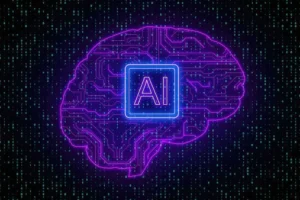Exploring AI UX Design Potential: 10 Ways AI Can Enhance Design

Artificial intelligence (AI) and user experience (UX) design form a compelling mix. AI UX design gives rise to high-quality products, more efficient websites, and satisfied clients through enhanced workflows and deeper user comprehension. This synergy allows designers to reveal their creative potential without the burden of monotonous tasks. Today, we’ll discuss the top 10 ways to supercharge your collaboration with AI tools further.
What is AI for UX?
AI for UX presents a toolkit that can make UX designers more productive. Predictive analytics, intelligent automation, and tailor-made suggestions amp up user engagement while simplifying the process of designing. Essentially, AI facilitates a more productive and user-centric workflow — it enables natural language processing (NLP), automates monotonous processes, and interprets user input.
Such a combination opens the door to understanding your products’ potential. In addition to being able to predict shopping trends, AI is also taking over automation. Those tasks that fell heavily on the shoulders of designers are transferred to AI — and it will cope with them perfectly. Designers will have time to realize their creative potential and not burden themselves with tedious tasks.
Statistics show the prevalence of this innovative collaboration. Adobe surveyed its consumers and provided concrete data. Fifty-seven percent of all consumers said that AI will increase their creativity, and among Gen Z, this number increased to 75 percent. About 90 percent of customer experience/marketing experts said it would help them do more and do better.
GlobalCloudTeam, a software developer with a solid track record, strongly advocates AI’s potential in the design industry. As part of our ongoing commitment to being on the cutting edge of technology, we’re here to help you incorporate AI into your design.

We are confident that we have what it takes to help you get your platform from the idea throughout design and development phases, all the way to successful deployment in a production environment!
10 Ways of How to Use AI in UX Design
Success in UX design depends on a thorough grasp of user demands. Still, it is challenging to keep ahead as user journeys are becoming more intricate. AI for UX design turns things around and offers many workflow optimization benefits. Let’s touch on the top 10 ways to benefit from AI in UX design.
Examine substantial amounts of user data
For UX designers, laboriously sorting through piles of user info by hand is a thing of the past. AI instruments have completely changed this procedure, making it possible to analyze enormous datasets quickly.
With so many new insights, designers fully understand the state of UX. They get the idea of how clients interact with a platform or website. This understanding allows you to verify design assumptions and rank the best solutions quickly. The outcome? Better usability and a user-focused product created with the target audience’s requirements in mind.
Increase output and efficiency
AI is a tireless personal helper to UX designers. This tech automates and enhances several operations. Therefore, it can promote increased productivity and simplify workflows. As an example, programs like Framer produce code and user-friendly layouts, while the AI-powered plugin Sketch2React transforms design files into HTML and CSS.
Furthermore, many design instruments have AI capabilities that automatically propose and design wireframes, prototypes, user interface (UI) components, and a host of other design outputs. AI automation has genuinely limitless possibilities.

Facilitate the process of designing UX
AI provides many automation options throughout the UX design process, from feature creation and prototype testing to deployment. Automation saves time in any area, and UX design is no exception. Let’s dwell on a few possibilities:
- Content creation. AI produces UX material in seconds, such as explanatory emails, help papers, and in-app text.
- Image generator. AI-fueled image generators may help with visual design — they produce stunning visual design components.
- Improved prototyping. Figma plugins use AI to automate processes like creating wireframes and prototypes.
- Code generation. AI quickly builds and distributes Figma designs by converting them into React code.
Undoubtedly, AI can’t replace the human touch in preparing exceptional UX. But it has become a powerful partner in the design. Automating repetitive duties is essential if you want to free UX designers and give them time for strategic thinking.
Create lifelike prototypes in a second
Prototyping is a major aspect of the UX design process. It lets designers quickly test and refine concepts. Moreover, prototypes help designers spot problems and ensure the finished product fulfills the needs and anticipations of the intended audience.
AI-powered technologies simplify the prototype process. Modern tools generate realistic user interactions predicated on design inputs and user data. They use AI’s predictive powers to model client behavior and interactions.
Enhance UX and product copy
Good user experience design requires better product copy than just functionality to lead customers through the customer journey. The selection of terminology is crucial, too. Clear navigational directions and educational feedback messages must be simple and understandable because you don’t want to complicate your user’s life.
AI technologies greatly help organizations without specialized UX writers since they are able to improve UX text. The systems use user profile data and known behavioral patterns to recommend word choices with useful info and unambiguous instructions. Overall, they facilitate enhanced user contact with the product and foster better navigation.
Fuel creativity
AI’s capabilities extend beyond automation and efficiency. It can also boost creativity and propel design processes forward, especially when encountering challenges.
For instance, designers can leverage AI to generate project briefs and user problems tailored to specific skill sets. This can be particularly useful when building a UX design portfolio or seeking new design challenges. A prompt like “Create UX design project briefs emphasizing research skills for my portfolio” can be used to instruct virtual assistants.
Moreover, you may ask for inspiration. Perhaps you’re planning a workshop and want to develop some fun exercises — so why not ask the chatbot to come up with ideas? Chatbots help get you off to a good start. According to a study, brainstorming with a chatbot resulted in more ideas on average and more diverse ones.

Enhance A/B testing
Artificial intelligence also revolutionizes A/B testing and significantly improves key statistical data. It conducts in-depth analyses of call-to-action (CTA) element variations, pinpointing their effect on conversion rates.
Leading A/B testing tools like Google Optimize, VWO, and Optimizely have embraced AI. They transformed them into even more robust platforms to carry out testing and analysis. The tools now use AI to expedite and facilitate various optimization processes.
Artificial intelligence in UX design offers specific recommendations to optimize CTAs. When you conduct A/B tests powered by AI, you can refine the CTA buttons’ design, color, and size.
Personalize UX design to get tailored experiences
Attracting and retaining customers necessitates personalized UX delivered through AI-powered design. According to a McKinsey analysis, customization contributes 40% more to the revenue of fast-growing organizations than for slower-growing ones.
Fortunately, AI UX design tools have grown to be invaluable allies — they empower companies to implement customized user journeys. This approach demonstrably enhances client engagement and revenue generation.
Users are wishing to visit a website that remembers past purchases and recommends similar products. Or an app that adapts its layout based on their device and browsing history. These are just a few examples of how AI personalizes UX design. It analyzes past interactions, preferences, and demographics to understand individual behavior. Therefore, it ushers a UX where adaptive interfaces adjust to client needs.
Reduce design bias
Design bias is a typical soft spot. It might appear as design features which cater to particular groups of people, making a product less useful and relevant to other consumers. As an example, a website style that predominantly accommodates right-handed users may inadvertently exclude left-handed visitors.
AI is a potential remedy for these biases. It can spot bias tendencies through the analysis of design decisions and user interactions. Now, designers can produce more equitable and diverse options that appeal to a larger spectrum of people. After all, it’s vital to ensure usability and functioning remain unaffected among all user groups.
Make use of predictive user behavior analysis
To provide the best possible product, it is essential to anticipate the needs and demands of customers, to understand what they want. AI comes to the rescue, as its arsenal of capabilities includes the function of detecting trends. Predictive AI is a game changer — it will analyze historic data to give you new predictions about what your users need and might be interested in.
Our ability to forecast future behavior is limited, but AI is quite good at this kind of work. It proactively customizes experiences and predicts future user preferences using user data. Amazon SageMaker, IBM Watson Studio, and Google Cloud Predictive Analytics are the primary technologies facilitating model creation, training, and modification. They study user information and needs and integrate deep learning.
Final Words
Concerns over AI technology’s ability to take over human labor have grown due to its advancement. Many people worry AI will replace many positions. However, a human-centered approach that considers users’ psychological and emotional elements — a domain in which AI’s skills are clearly limited — makes AI UX design succeed. AI is excellent at data analysis, finding patterns in data, and even coming up with ideas based on existing data, but it lacks natural creativity — a critical human skill.
Consequently, the alternative is to use AI to complement human UX design input rather than replace it entirely. Though AI has many advantages and disadvantages, it can make UX more compelling and intuitive. AI and UX enable website owners and designers to establish more meaningful relationships with their target market, making it easier to customize goods and services to meet the specific demands of each customer. This all-encompassing strategy ensures every user contact is significant and spruces up the product’s ease of use.
To experience success in AI UX design, partner with leading companies to accelerate your journey. GlobalCloudTeam is your go-to choice. We can help you bring the power of AI UX design to projects, forming experiences that are not just functional but truly exceptional.
Top Articles
The Primary Aspects of High Performance Computing (HPC)
I am here to help you!
Explore the possibility to hire a dedicated R&D team that helps your company to scale product development.






